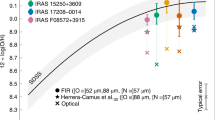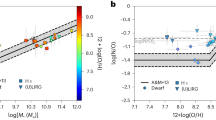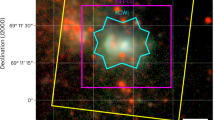Abstract
The interstellar medium (ISM) comprises gases at different temperatures and densities, including ionized, atomic and molecular species, and dust particles1. The neutral ISM is dominated by neutral hydrogen2 and has ionization fractions of up to eight per cent3. The concentration of chemical elements heavier than helium (metallicity) spans orders of magnitudes in Galactic stars4, because they formed at different times. However, the gas in the vicinity of the Sun is assumed to be well mixed and to have a solar metallicity in traditional chemical evolution models5. The ISM chemical abundances can be accurately measured with ultraviolet absorption-line spectroscopy. However, the effects of dust depletion6,7,8,9—which removes part of the metals from the observable gaseous phase and incorporates it into solid grains—have prevented, until recently, a deeper investigation of the ISM metallicity. Here we report the dust-corrected metallicity of the neutral ISM measured towards 25 stars in our Galaxy. We find large variations in metallicity over a factor of ten (with an average of 55 ± 7 per cent solar metallicity and a standard deviation of 0.28 dex), including many regions of low metallicity, down to about 17 per cent solar metallicity and possibly below. Pristine gas falling onto the Galactic disk in the form of high-velocity clouds can cause the observed chemical inhomogeneities on scales of tens of parsecs. Our results suggest that this low-metallicity accreting gas does not efficiently mix into the ISM, which may help us understand metallicity deviations in nearby coeval stars.
This is a preview of subscription content, access via your institution
Access options
Access Nature and 54 other Nature Portfolio journals
Get Nature+, our best-value online-access subscription
$29.99 / 30 days
cancel any time
Subscribe to this journal
Receive 51 print issues and online access
$199.00 per year
only $3.90 per issue
Buy this article
- Purchase on Springer Link
- Instant access to full article PDF
Prices may be subject to local taxes which are calculated during checkout



Similar content being viewed by others
Data availability
The observational data used in this work are publicly available in the Mikulski Archive for Space Telescope (HST/STIS data, programme ID 15335, principal investigator A.D.C., https://doi.org/10.17909/t9-r14v-tp03) and the ESO Science Archive Facility (VLT/UVES data http://archive.eso.org/wdb/wdb/adp/phase3_spectral/form?). The data used in the figures and tables are available as electronically readable source data files, except for the publicly available observational data (Extended Data Fig. 1). Source data are provided with this paper.
Code availability
The VoigtFit software is publicly available on GitHub at https://github.com/jkrogager/VoigtFit.
Change history
03 November 2021
A Correction to this paper has been published: https://doi.org/10.1038/s41586-021-04146-2
References
Draine, B. T. Physics of the Interstellar and Intergalactic Medium (Princeton Univ. Press, 2011).
Viegas, S. M. Abundances at high redshift: ionization correction factors. Mon. Not. R. Astron. Soc. 276, 268–272 (1995).
Jenkins, E. B. The fractional ionization of the warm neutral interstellar medium. Astrophys. J. 764, 25 (2013).
McWilliam, A. Abundance ratios and galactic chemical evolution. Annu. Rev. Astron. Astrophys. 35, 503-556 (1997).
Matteucci, F. Chemical Evolution of Galaxies (Astronomy and Astrophysics Library, Springer, 2012).
Field, G. B. Interstellar abundances: gas and dust. Astrophys. J. 187, 453–459 (1974).
Savage, B. D. & Sembach, K. R. Interstellar abundances from absorption-line observations with the Hubble Space Telescope. Annu. Rev. Astron. Astrophys. 34, 279–330 (1996).
Jenkins, E. B. A unified representation of gas-phase element depletions in the interstellar medium. Astrophys. J. 700, 1299–1348 (2009).
De Cia, A. et al. Dust-depletion sequences in damped Lyman-α absorbers. A unified picture from low-metallicity systems to the Galaxy. Astron. Astrophys. 596, A97 (2016).
Arellano-Córdova, K. Z., Esteban, C., Garca-Rojas, J. & Méndez-Delgado, J. E. The Galactic radial abundance gradients of C, N, O, Ne, S, Cl, and Ar from deep spectra of H II regions. Mon. Not. R. Astron. Soc. 496, 1051–1076 (2020).
Edmunds, M. G. Is the Galactic Disk well mixed? Astrophys. Space Sci. 32, 483–491 (1975).
Tosi, M. The effect of metal-rich infall on galactic chemical evolution. Astron. Astrophys. 197, 47–51 (1988).
Chiappini, C., Matteucci, F. & Gratton, R. The chemical evolution of the Galaxy: the two-infall model. Astrophys. J. 477, 765–780 (1997).
Edvardsson, B. et al. The chemical evolution of the Galactic disk. I. Analysis and results. Astron. Astrophys. 275, 101–152 (1993).
Pilyugin, L. S. & Edmunds, M. G. Chemical evolution of the Milky Way Galaxy. II. On the origin of scatter in the age–metallicity relation. Astron. Astrophys. 313, 792–802 (1996).
White, S. D. M. & Audouze, J. Stochastic effects in the chemical evolution of galaxies. Mon. Not. R. Astron. Soc. 203, 603–618 (1983).
de Avillez, M. A. & Mac Low, M. M. Mixing timescales in a supernova-driven interstellar medium. Astrophys. J. 581, 1047–1060 (2002).
Andrews, S. M., Meyer, D. M. & Lauroesch, J. T. Small-scale interstellar Na I structure toward M92. Astrophys. J. Lett. 552, L73–L76 (2001).
Nasoudi-Shoar, S., Richter, P., de Boer, K. S. & Wakker, B. P. Interstellar absorptions towards the LMC: small-scale density variations in Milky Way disc gas. Astron. Astrophys. 520, A26 (2010).
Fox, A. J. & Davé, R. Gas Accretion onto Galaxies (Astrophysics and Space Science Library 430, Springer, 2017).
Wright, R. J., Lagos, C. P., Power, C. & Correa, C. A. Revealing the physical properties of gas accreting to haloes in the EAGLE simulations. Mon. Not. R. Astron. Soc. 504, 5702–5725 (2021).
Gritton, J. A., Shelton, R. L. & Kwak, K. Mixing between high velocity clouds and the Galactic halo. Astrophys. J. 795, 99 (2014).
Heitsch, F. & Putman, M. E. The fate of high-velocity clouds: warm or cold cosmic rain? Astrophys. J. 698, 1485–1496 (2009).
Putman, M. E., Peek, J. E. G. & Joung, M. R. Gaseous galaxy halos. Annu. Rev. Astron. Astrophys. 50, 491–529 (2012).
Richter, P. Gas Accretion onto the Milky Way (Astrophysics and Space Science Library 430, Springer, 2017).
Lehner, N. & Howk, J. C. A reservoir of ionized gas in the Galactic halo to sustain star formation in the Milky Way. Science 334, 955–958 (2011).
Fox, A. J. et al. The mass inflow and outflow rates of the Milky Way. Astrophys. J. 884, 53 (2019).
Cheng, J. Y. et al. Metallicity gradients in the Milky Way disk as observed by the SEGUE survey. Astrophys. J. 746, 149 (2012).
Wendt, M., Bouché, N. F., Zabl, J., Schroetter, I. & Muzahid, S. MUSE gas flow and wind V. The dust/metallicity-anisotropy of the circum-galactic medium. Mon. Not. R. Astron. Soc. 502, 3733–3745 (2021).
Welty, D. E. & Crowther, P. A. Interstellar Ti II in the Milky Way and Magellanic Clouds. Mon. Not. R. Astron. Soc. 404, 1321–1348 (2010).
Diplas, A. & Savage, B. D. An IUE survey of interstellar H i Ly α absorption. I. Column densities. Astrophys. J. Suppl. Ser. 93, 211–228 (1994).
Savage, B. D., Bohlin, R. C., Drake, J. F. & Budich, W. A survey of interstellar molecular hydrogen. I. Astrophys. J. 216, 291–307 (1977).
Gaia Collaboration et al. The Gaia mission. Astron. Astrophys. 595, A1 (2016).
Gaia Collaboration et al. Gaia Data Release 2. Summary of the contents and survey properties. Astron. Astrophys. 616, A1 (2018).
Welty, D. E., Sonnentrucker, P., Snow, T. P. & York, D. G. HD 62542: probing the bare, dense core of a translucent interstellar cloud. Astrophys. J. 897, 36, (2020).
Valencic, L. A., Clayton, G. C. & Gordon, K. D. Ultraviolet extinction properties in the Milky Way. Astrophys. J. 616, 912–924 (2004).
Savage, B. D. & Sembach, K. R. The analysis of apparent optical depth profiles for interstellar absorption lines. Astrophys. J. 379, 245–259 (1991).
Jenkins, E. B. A procedure for correcting the apparent optical depths of moderately saturated interstellar absorption lines. Astrophys. J. 471, 292–301 (1996).
Sembach, K. R. & Savage, B. D. Observations of highly ionized gas in the Galactic halo. Astrophys. J. Suppl. Ser. 83, 147–201 (1992).
Bowen, D. V. et al. The Far Ultraviolet Spectroscopic Explorer Survey of O VI absorption in the disk of the Milky Way. Astrophys. J. Suppl. Ser. 176, 59–163 (2008).
Krogager, J.-K. VoigtFit: a Python package for Voigt profile fitting. Preprint at https://arxiv.org/abs/1803.01187 (2018).
Price, R. J., Crawford, I. A., Barlow, M. J. & Howarth, I. D. An ultra-high-resolution study of the interstellar medium towards Orion. Mon. Not. R. Astron. Soc. 328, 555–582 (2001).
Phillips, A. P., Gondhalekar, P. M. & Pettini, M. A study of element depletions in interstellar gas. Mon. Not. R. Astron. Soc. 200, 687–703 (1982).
Jenkins, E. B., Savage, B. D. & Spitzer, L. Jr Abundances of interstellar atoms from ultraviolet absorption lines. Astrophys. J. 301, 355–379 (1986).
Roman-Duval, J. et al. METAL: The Metal Evolution, Transport, and Abundance in the Large Magellanic Cloud Hubble program. II. Variations of interstellar depletions and dust-to-gas ratio within the LMC. Astrophys. J. 910, 95 (2021).
De Cia, A. Metals and dust in the neutral ISM: the Galaxy, Magellanic Clouds, and damped Lyman-α absorbers Astron. Astrophys. 613, L2 (2018).
Jenkins, E. B. A closer look at some gas-phase depletions in the ISM: trends for O, Ge, and Kr versus F*, f(H2), and starlight intensity. Astrophys. J. 872, 55 (2019).
De Cia, A., Ledoux, C., Petitjean, P. & Savaglio, S. The cosmic evolution of dust-corrected metallicity in the neutral gas. Astron. Astrophys. 611, A76 (2018).
Simón-Díaz, S. The chemical composition of the Orion star forming region. I. Homogeneity of O and Si abundances in B-type stars. Astron. Astrophys. 510, A22 (2010).
Rubin, R. H., Dufour, R. J. and Walter, D. K. Silicon and carbon abundances in the Orion nebula. Astrophys. J. 413, 242–250 (1993).
Garnett, D. R. et al. Si/O abundance ratios in extragalactic H II regions from Hubble Space Telescope UV spectroscopy. Astrophys. J. 449, L77–L81 (1995).
Simón-Díaz, S. & Stasińska, G. The chemical composition of the Orion star forming region. II. Stars, gas, and dust: the abundance discrepancy conundrum. Astron. Astrophys. 526, A48 (2011).
Esteban, C. et al. A reappraisal of the chemical composition of the Orion nebula based on Very Large Telescope echelle spectrophotometry. Mon. Not. R. Astron. Soc. 355, 229–247 (2004).
Esteban, C. & García-Rojas, J. Revisiting the radial abundance gradients of nitrogen and oxygen of the Milky Way. Mon. Not. R. Astron. Soc. 478, 2315–2336 (2018).
Balser, D. S., Wenger, T. V., Anderson, L. D. and Bania, T. M. Azimuthal metallicity structure in the Milky Way Disk. Astrophys. J. 806, 199 (2015).
Wang, E. & Lilly, S. J. Gas-phase metallicity as a diagnostic of the drivers of star-formation on different scales. Astrophys. J. 910, 137 (2021).
Kreckel, K. et al. Mapping metallicity variations across nearby Galaxy disks. Astrophys. J. 887, 80 (2019).
Kreckel, K. et al. Measuring the mixing scale of the ISM within nearby spiral galaxies. Mon. Not. R. Astron. Soc. 499, 193–209 (2020).
McMillan, P. J. Mass models of the Milky Way. Mon. Not. R. Astron. Soc. 414, 2446–2457 (2011).
Cashman, F. H., Kulkarni, V. P., Kisielius, R., Ferland, G. J. & Bogdanovich, P. Atomic data revisions for transitions relevant to observations of interstellar, circumgalactic, and intergalactic matter. Astrophys. J. Suppl. Ser. 230, 8 (2017).
Morton, D. C. Atomic data for resonance absorption lines. III. Wavelengths longward of the Lyman limit for the elements hydrogen to gallium. Astrophys. J. Suppl. Ser. 149, 205–238 (2003).
Boissé, P. & Bergeron, J. Improved Ni II oscillator strengths from quasar absorption systems. Astron. Astrophys. 622, A140 (2019).
Kisielius, R. et al. Atomic data for Zn II: improving spectral diagnostics of chemical evolution in high-redshift galaxies. Astrophys. J. 804, 76 (2015).
Jenkins, E. B. & Tripp, T. M. Measurements of the f-values of the resonance transitions of Ni II at 1317.217 and 1370.132 Å. Astrophys. J. 637, 548–552 (2006).
Wiseman, P. et al. Evolution of the dust-to-metals ratio in high-redshift galaxies probed by GRB-DLAs. Astron. Astrophys. 599, A24 (2017).
Acknowledgements
A.D.C. thanks C. Chiosi and the ‘Galaxies and the Universe’ group at the University of Geneva for discussions, and B. Holl for help with navigating the Gaia archive. A.D.C., T.R.-H., C.K. and J.-K.K. acknowledge support by the Swiss National Science Foundation under grant 185692. Based on observations with the NASA/ESA Hubble Space Telescope obtained at the Space Telescope Science Institute (STScI), which is operated by the Association of Universities for Research in Astronomy, Incorporated, under NASA contract NAS5-26555. E.B.J. was supported by grant number HST-GO-15335.002-A from STScI to Princeton University. Based on data obtained from the ESO Science Archive Facility. This work has made use of data from the European Space Agency (ESA) mission Gaia (https://www.cosmos.esa.int/gaia), processed by the Gaia Data Processing and Analysis Consortium (DPAC, https://www.cosmos.esa.int/web/gaia/dpac/consortium). Funding for the DPAC has been provided by national institutions, in particular the institutions participating in the Gaia Multilateral Agreement. The background image in Fig. 1 is courtesy of NASA/JPL-Caltech/R. Hurt (SSC/Caltech).
Author information
Authors and Affiliations
Contributions
A.D.C. initiated, designed and directed the project, is the principal investigator of the HST data, analysed and interpreted the data, developed and applied the main methodology, and wrote the bulk of the manuscript. E.B.J. reduced the HST data and retrieved the UVES data, analysed and interpreted the data, measured the column densities, developed and applied one of the two methods to measure the metallicity, contributed to the writing and produced Fig. 3. A.J.F. contributed to the writing and scientific design of the paper. C.L. checked the consistency of the analysis, helped interpret the data and contributed to the writing. E.B.J., C.L., A.J.F. and P.P. are co-investigators of the HST data. T.R.-H. measured the position of our targets within the Galaxy and produced Fig. 1 and Extended Data Fig. 4. C.K. reviewed the depletion methods and assumptions, and collected data from Galactic extinction maps. P.P. contributed to the prioritization of the scientific goals and the writing. J.-K.K. assessed the ionization effects and contributed to the writing. J.-K.K., T.R.-H., C.K., C.L. and A.D.C. measured the column densities towards eight targets with an independent method for a cross-check of the results. All authors participated in the scientific interpretation, edited the manuscript and contributed to its revision.
Corresponding author
Ethics declarations
Competing interests
The authors declare no competing interests.
Additional information
Peer review information Nature thanks the anonymous reviewers for their contribution to the peer review of this work.
Publisher’s note Springer Nature remains neutral with regard to jurisdictional claims in published maps and institutional affiliations.
Extended data figures and tables
Extended Data Fig. 1 Line profiles of Zn ii λ2026 (black), Cr ii λ2056 (blue) and Fe ii λ2260 (green) in our sample.
The Mg i λ2026 line is separated by ~50 km s−1 from Zn ii. Vertical lines mark the zero-velocity central wavelength of the Zn ii line. The yellow curve shows the 1σ uncertainties.
Extended Data Fig. 2 Determination of the metallicity and strength of depletion with the relative method.
Extended Data Fig. 3 Determination of [M/H]tot and F* with the F* method.
The variables are described in equation (8). The most volatile elements (red) are taken from the literature (Extended Data Table 6) and shown for reference: their discrepancy with respect to the more refractory elements suggests a mix between high-metallicity and pristine gas, see Methods. The error bars show the 1σ uncertainties.
Extended Data Fig. 4 Metallicity towards our targets and their Galactic location.
a, Metallicities towards our targets and their Galactic radii. The green dotted line shows the metallcity gradient measured in H ii regions by ref. 10, although without dust corrections. The solar Galactic radius (red cross) is assumed at 8.29 kpc 59. The error bars show the 1σ uncertainties. b, Metallicities towards our targets and their height above the Galactic Disk. The error bars show the 1σ uncertainties.
Supplementary information
Rights and permissions
About this article
Cite this article
De Cia, A., Jenkins, E.B., Fox, A.J. et al. Large metallicity variations in the Galactic interstellar medium. Nature 597, 206–208 (2021). https://doi.org/10.1038/s41586-021-03780-0
Received:
Accepted:
Published:
Issue Date:
DOI: https://doi.org/10.1038/s41586-021-03780-0
This article is cited by
-
The Fermi/eROSITA bubbles: a look into the nuclear outflow from the Milky Way
The Astronomy and Astrophysics Review (2024)
Comments
By submitting a comment you agree to abide by our Terms and Community Guidelines. If you find something abusive or that does not comply with our terms or guidelines please flag it as inappropriate.



